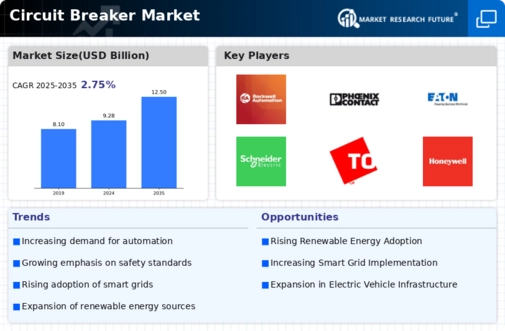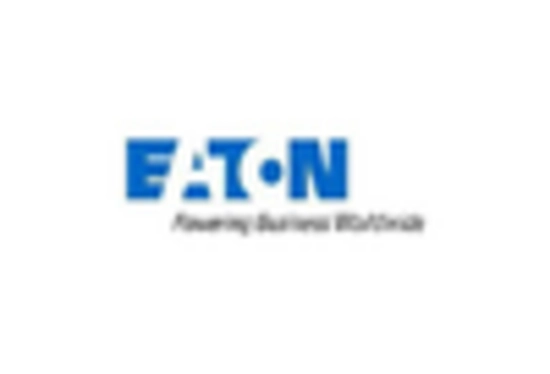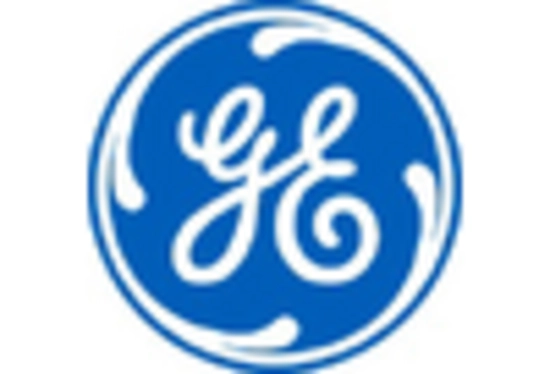Rising Demand for Renewable Energy
The Circuit Breaker Market is experiencing a notable surge in demand due to the increasing adoption of renewable energy sources. As countries strive to meet energy transition goals, the integration of solar and wind energy systems necessitates advanced circuit protection solutions. In 2025, the renewable energy sector is projected to account for a significant portion of new electricity generation capacity, thereby driving the need for reliable circuit breakers. These devices are essential for ensuring the safety and efficiency of renewable energy installations, which often operate under variable conditions. Consequently, manufacturers in the Circuit Breaker Market are innovating to develop products that can withstand the unique challenges posed by renewable energy systems, such as fluctuating loads and grid stability issues.
Increased Focus on Safety Standards
The Circuit Breaker Market is significantly influenced by the heightened focus on safety standards across various sectors. Regulatory bodies are continuously updating safety regulations to mitigate electrical hazards, which in turn drives the demand for advanced circuit breakers. In 2025, it is anticipated that stricter compliance requirements will be enforced, compelling industries to adopt more sophisticated circuit protection solutions. This trend is particularly evident in sectors such as construction, manufacturing, and residential applications, where the risk of electrical faults can have severe consequences. As a result, manufacturers are likely to invest in research and development to create circuit breakers that not only comply with existing standards but also exceed them, thereby enhancing safety and reliability in electrical systems.
Infrastructure Development Projects
Infrastructure development projects are a critical driver for the Circuit Breaker Market, particularly in emerging economies. Governments are investing heavily in upgrading and expanding electrical infrastructure to support urbanization and industrial growth. In 2025, the global infrastructure investment is expected to reach unprecedented levels, with a substantial portion allocated to electrical grid enhancements. This trend necessitates the installation of advanced circuit breakers to ensure the reliability and safety of electrical systems. As new buildings and facilities are constructed, the demand for modern circuit protection solutions will likely increase, prompting manufacturers to focus on innovative designs that meet the evolving needs of the construction sector. The Circuit Breaker Market is thus positioned to benefit from this wave of infrastructure investment.
Growing Urbanization and Electrification
The phenomenon of urbanization is a significant driver for the Circuit Breaker Market, as more people migrate to urban areas, the demand for reliable electrical infrastructure intensifies. In 2025, urban areas are projected to house a majority of the global population, leading to increased electrification efforts to support residential, commercial, and industrial needs. This trend necessitates the installation of efficient circuit breakers to manage the growing electrical loads and ensure system reliability. Additionally, as cities expand, the complexity of electrical networks increases, further driving the need for advanced circuit protection solutions. The Circuit Breaker Market is thus poised to benefit from the ongoing urbanization trends, as stakeholders seek to enhance the safety and efficiency of electrical systems in densely populated areas.
Technological Innovations in Circuit Breakers
Technological innovations are reshaping the Circuit Breaker Market, with advancements in smart technology and automation playing a pivotal role. The integration of IoT and smart grid technologies is enabling circuit breakers to offer enhanced monitoring and control capabilities. In 2025, the market is expected to witness a growing trend towards smart circuit breakers that can communicate with other devices and systems, providing real-time data on electrical performance. This shift towards intelligent solutions is likely to improve operational efficiency and reduce downtime in various applications. As industries increasingly prioritize automation and data-driven decision-making, the demand for technologically advanced circuit breakers will continue to rise, positioning the Circuit Breaker Market for substantial growth.

















Leave a Comment